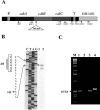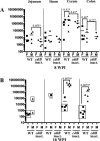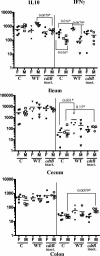Cytolethal distending toxin is essential for Helicobacter hepaticus colonization in outbred Swiss Webster mice
- PMID: 15908385
- PMCID: PMC1111878
- DOI: 10.1128/IAI.73.6.3559-3567.2005
Cytolethal distending toxin is essential for Helicobacter hepaticus colonization in outbred Swiss Webster mice
Abstract
Helicobacter hepaticus, which induces chronic hepatitis and typhlocolitis in susceptible mouse strains, produces a cytolethal distending toxin (CDT) consisting of CdtA, CdtB, and CdtC. A cdtB-deficient H. hepaticus isogenic mutant (HhcdtBm7) was generated and characterized for colonization parameters in four intestinal regions (jejunum, ileum, cecum, and colon) of outbred Swiss Webster (SW) mice. Inactivation of the cdtB gene abolished the ability of HhcdtBm7 to colonize female mice at both 8 and 16 weeks postinfection (wpi), whereas HhcdtBm7 colonized all of four intestinal regions of three of five males at 8 wpi and then was eliminated by 16 wpi. Wild-type (WT) H. hepaticus was detected in the corresponding intestinal regions of both male and female mice at 8 and 16 wpi; however, colonization levels of WT H. hepaticus in the cecum and colon of male mice were approximately 1,000-fold higher than in females (P < 0.0079) at 16 wpi. Infection with WT H. hepaticus, but not HhcdtBm7, at 8 wpi was associated with significantly increased mRNA level of ileal and cecal gamma interferon (IFN-gamma) in females (P < 0.016 and 0.031 between WT H. hepaticus-infected and sham-dosed females, respectively). In contrast, the mRNA levels of IFN-gamma were significantly higher in the colon (P < 0.0079) and trended to be higher in the cecum (P < 0.15) in the HhcdtBm7-colonized male mice versus the sham-dosed controls at 8 wpi. In addition, mRNA levels of ileal IFN-gamma were significantly higher in the control females than males at 8 wpi (P < 0.016). There were significantly higher Th1-associated immunoglobulin G2a (IgG2a), Th2-associated IgG1 and mucosal IgA (P < 0.002, 0.002, 0.002, respectively) responses in the mice infected with WT H. hepaticus when compared to HhcdtBm7 at 16 wpi. Colonic interleukin-10 (IL-10) expressions at 16 wpi were significantly lower in both female and male mice colonized by WT H. hepaticus or in males transiently colonized through 8 wpi by HhcdtBm7 versus control mice (P < 0.0159). These lines of evidence indicate that (i) H. hepaticus CDT plays a crucial role in the persistent colonization of H. hepaticus in SW mice; (ii) SW female mice are more resistant to H. hepaticus colonization than male mice; (iii) there was persistent colonization of WT H. hepaticus in cecum, colon, and jejunum but only transient colonization of H. hepaticus in the ileum of female mice; (iv) H. hepaticus colonization was associated with down-regulation of colonic IL-10 production.
Figures





Similar articles
-
Modulation of host immune responses by the cytolethal distending toxin of Helicobacter hepaticus.Infect Immun. 2006 Aug;74(8):4496-504. doi: 10.1128/IAI.00503-06. Infect Immun. 2006. PMID: 16861635 Free PMC article.
-
Helicobacter hepaticus cytolethal distending toxin promotes intestinal carcinogenesis in 129Rag2-deficient mice.Cell Microbiol. 2017 Jul;19(7):10.1111/cmi.12728. doi: 10.1111/cmi.12728. Epub 2017 Feb 20. Cell Microbiol. 2017. PMID: 28111881 Free PMC article.
-
Cytolethal distending toxin promotes Helicobacter cinaedi-associated typhlocolitis in interleukin-10-deficient mice.Infect Immun. 2009 Jun;77(6):2508-16. doi: 10.1128/IAI.00166-09. Epub 2009 Mar 23. Infect Immun. 2009. PMID: 19307212 Free PMC article.
-
In vivo virulence properties of bacterial cytolethal-distending toxin.Cell Microbiol. 2008 Aug;10(8):1599-607. doi: 10.1111/j.1462-5822.2008.01173.x. Epub 2008 May 16. Cell Microbiol. 2008. PMID: 18489725 Review.
-
Helicobacter hepaticus infection in mice: models for understanding lower bowel inflammation and cancer.Mucosal Immunol. 2011 Jan;4(1):22-30. doi: 10.1038/mi.2010.61. Epub 2010 Oct 13. Mucosal Immunol. 2011. PMID: 20944559 Free PMC article. Review.
Cited by
-
Gamma-glutamyltranspeptidase expression by Helicobacter saguini, an enterohepatic Helicobacter species isolated from cotton top tamarins with chronic colitis.Cell Microbiol. 2019 Mar;21(3):e12968. doi: 10.1111/cmi.12968. Epub 2018 Nov 14. Cell Microbiol. 2019. PMID: 30365223 Free PMC article.
-
Helicobacter hepaticus Infection Promotes the Progression of Liver Preneoplasia in BALB/c Mice via the Activation and Accumulation of High-Mobility Group Box-1.Front Microbiol. 2022 Jan 3;12:789752. doi: 10.3389/fmicb.2021.789752. eCollection 2021. Front Microbiol. 2022. PMID: 35046917 Free PMC article.
-
Role of the Helicobacter hepaticus flagellar sigma factor FliA in gene regulation and murine colonization.J Bacteriol. 2008 Oct;190(19):6398-408. doi: 10.1128/JB.00626-08. Epub 2008 Aug 8. J Bacteriol. 2008. PMID: 18689480 Free PMC article.
-
Interleukin-22 drives nitric oxide-dependent DNA damage and dysplasia in a murine model of colitis-associated cancer.Mucosal Immunol. 2017 Nov;10(6):1504-1517. doi: 10.1038/mi.2017.9. Epub 2017 Feb 15. Mucosal Immunol. 2017. PMID: 28198364 Free PMC article.
-
Campylobacter jejuni type VI secretion system: roles in adaptation to deoxycholic acid, host cell adherence, invasion, and in vivo colonization.PLoS One. 2012;7(8):e42842. doi: 10.1371/journal.pone.0042842. Epub 2012 Aug 27. PLoS One. 2012. PMID: 22952616 Free PMC article.
References
-
- Chien, C. C., N. S. Taylor, Z. Ge, D. B. Schauer, V. B. Young, and J. G. Fox. 2000. Identification of cdtB homologues and cytolethal distending toxin activity in enterohepatic Helicobacter spp. J. Med. Microbiol. 49:525-534. - PubMed
Publication types
MeSH terms
Substances
Grants and funding
LinkOut - more resources
Full Text Sources
Medical
Molecular Biology Databases
Miscellaneous

